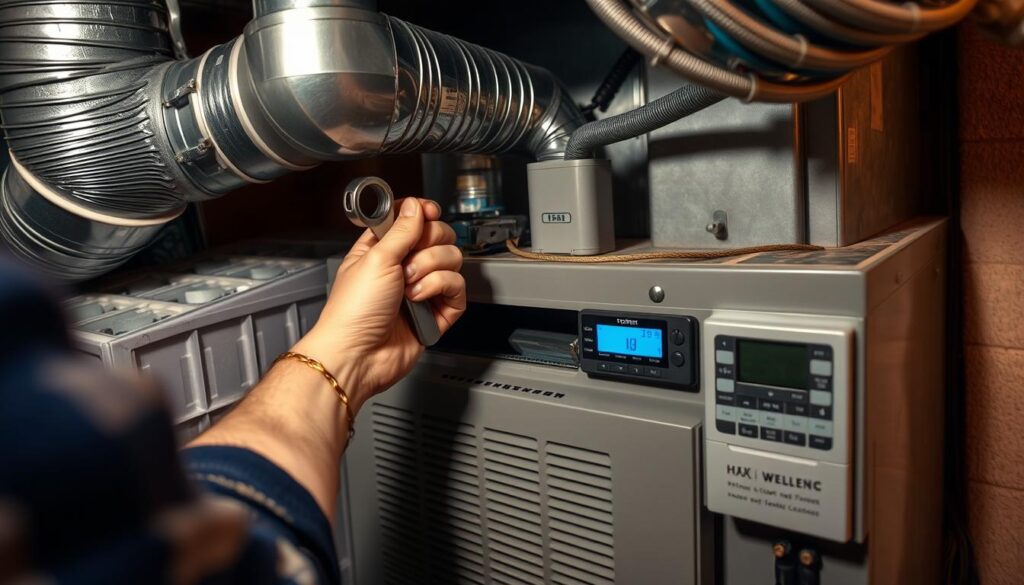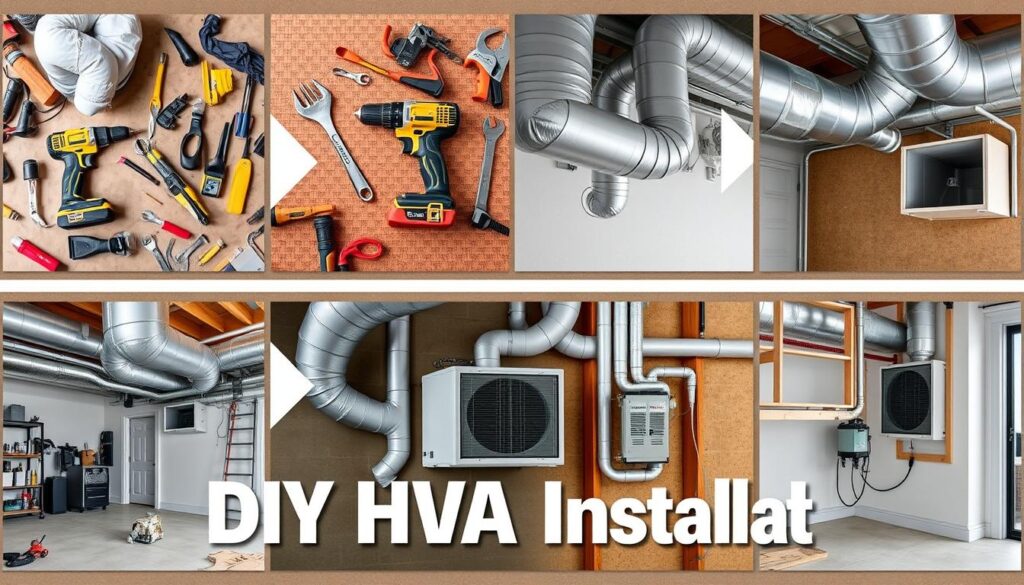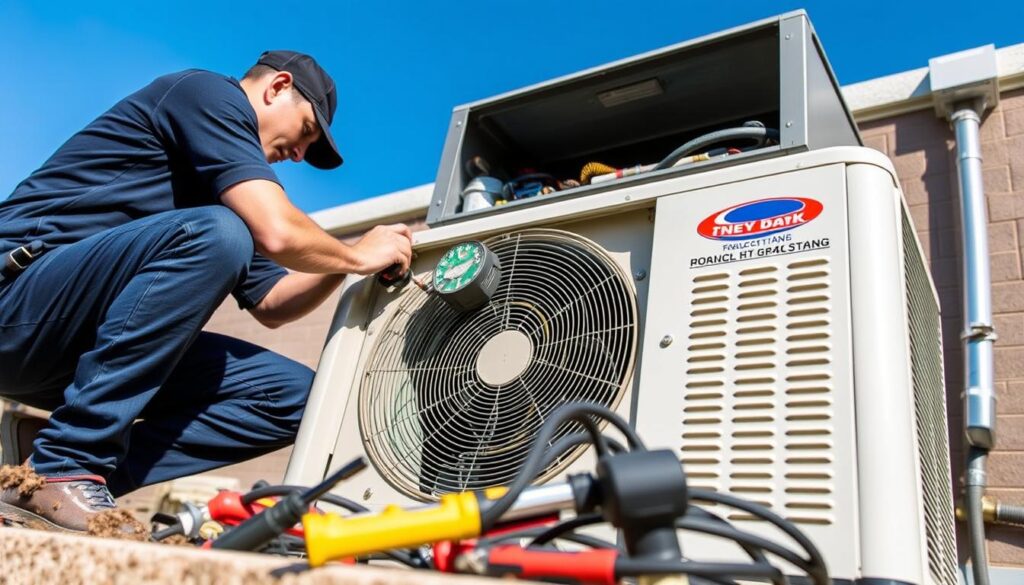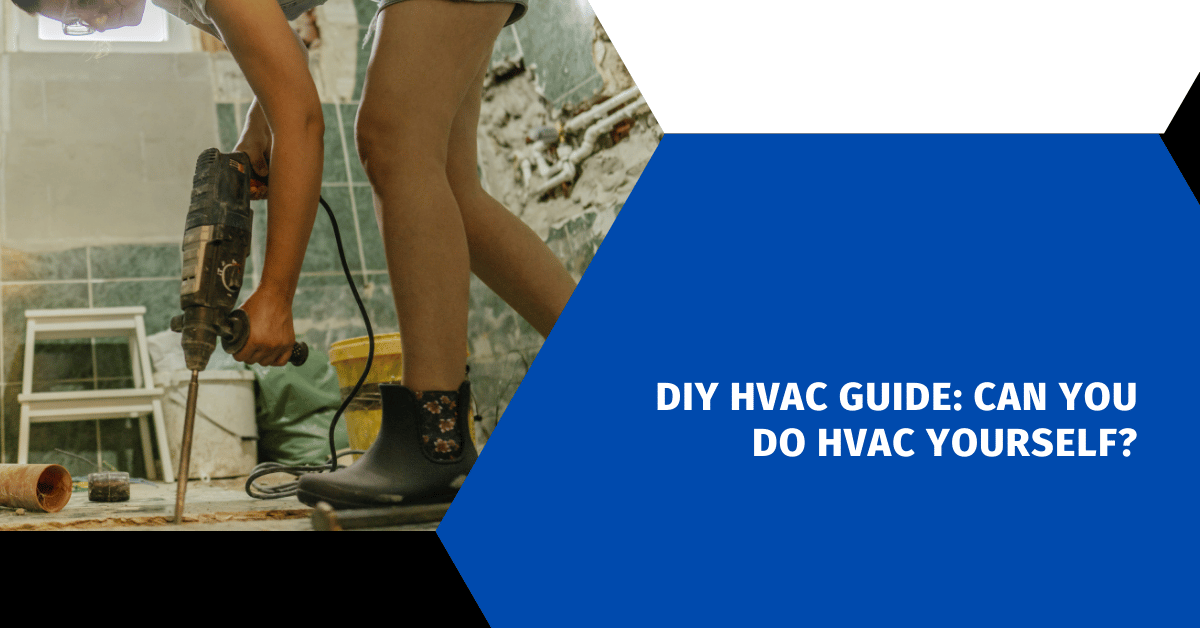Affiliate Disclosure
HVAC Guide Guys is a participant in the Amazon Services LLC Associates Program, an affiliate advertising program designed to provide a means for sites to earn advertising fees by advertising and linking to Amazon.
Can You Do HVAC Yourself? “The only way to do great work is to love what you do.” – Steve Jobs
As a homeowner, you know how important it is to keep your home comfortable and energy-efficient. Your HVAC system is key to this. It affects your home’s comfort, energy use, and air quality. While some tasks need a pro, many homeowners can handle maintenance and even install systems themselves.
In this DIY HVAC guide, we’ll dive into home heating and cooling. You’ll learn how to manage your HVAC system. From understanding its parts to doing DIY tasks, this guide will help you improve your home’s comfort and energy use.

Key Takeaways
- HVAC maintenance is crucial for comfort, efficiency, and air quality
- Many HVAC maintenance tasks can be performed by homeowners to save costs
- Proper DIY HVAC maintenance can extend the system’s lifespan and improve performance
- Understanding the basic components and function of HVAC systems is key for effective DIY work
- Safety should always be the top priority when undertaking DIY HVAC projects
Table of Contents
Understanding the Basics of HVAC Systems
HVAC (Heating, Ventilation, and Air Conditioning) systems keep our spaces comfortable all year. They have many parts that work together. Knowing about these parts and how they work is key for anyone interested in DIY HVAC projects.
Components of an HVAC System
The main parts of an HVAC system are thermostats, furnaces, air conditioners, heat pumps, and ductwork. Thermostats let you control the temperature and check the system’s status. Furnaces and air conditioners handle heating and cooling. Heat pumps can do both. The ductwork spreads the cooled or heated air around the building.
How HVAC Systems Function
HVAC systems either heat or cool the air and send it through ducts. When heating, the furnace warms the air, which then goes into the rooms. When cooling, the air conditioner or heat pump takes heat out of the air and sends cool, dry air inside.
Types of HVAC Systems
There are many HVAC systems, each with its own benefits. Split systems have indoor and outdoor units. Packaged systems put everything in one outdoor unit. Ductless mini-split systems offer zone-specific heating and cooling without needing lots of ductwork.
Knowing the basics of HVAC systems is crucial for homeowners or DIY fans. By understanding the components, how they work, and the different types, you can make better choices. This knowledge can also help you tackle some HVAC tasks on your own.
Can You Do HVAC Yourself?
The idea of DIY HVAC installation might seem appealing. But, it’s important to know the challenges involved. HVAC self-installation needs special skills, tools, and knowledge. In places like New Jersey, you can buy equipment and try to install it without a license.
This lack of rules can be a worry. DIY HVAC projects might not be safe or of good quality. Professional HVAC technicians stress the need for training and experience. They say DIY attempts often lack these essential skills.
Some homeowners might think DIY saves money. But, it’s key to think about the long-term costs. If DIY fails, getting a pro might cost more and lower the quality. The risks of bad HVAC work are too high to ignore.
“Proper handling of refrigerants requires technicians to be certified in refrigerant handling techniques by the EPA. Improper handling can lead to safety and environmental concerns.”
Whether to do HVAC work yourself depends on your skills, time, and resources. Some tasks might be doable for a handy homeowner. But, installing a whole system is best left to licensed pros. They ensure your home’s heating and cooling works safely and efficiently.
Essential Tools and Equipment for DIY HVAC Work
Starting DIY HVAC projects needs more than basic tools. It’s key to get the right equipment for a safe and successful job. Having the right tools is vital for your HVAC system’s efficiency and your safety.
Basic Hand Tools Required
- Wrenches, pliers, and screwdrivers for general repair and maintenance tasks
- Cordless drill for improved mobility and convenience in tight spaces
- Utility knife for cutting insulation or opening boxes of parts
- Service wrenches to open and close refrigeration valves
- Tube and pipe cutters for cutting copper and PVC pipes
- Combo linesman or needle-nose pliers with wire strippers and crimpers
- Long neck nut driver sets for working in confined areas
- Lightweight aluminum pipe wrenches for easier handling
- Adjustable wrenches, channel locks, and pipe calipers for various tasks
Specialized HVAC Tools
DIY HVAC work also needs special tools for accurate system checks and maintenance. These include:
- Multimeters with air temperature sensors and amp probes
- Digital refrigerant gauges for precise pressure and temperature readings
- Digital probes for quick and accurate measurements within the HVAC system
- Refrigerant scales, crimping tools, and manifold gauges for system maintenance
- Diagnostic tools like thermal imaging cameras and anemometers for system analysis
Safety Equipment Needed
Protecting yourself is crucial when working on HVAC systems. Essential safety gear includes:
- Gloves to prevent cuts and burns
- Safety glasses to protect your eyes
- Respirators or masks to filter out airborne particles
- Lighting solutions like flashlights and LED headlamps for improved visibility
Investing in the right HVAC tools, DIY HVAC equipment, and HVAC safety gear is a big step. It can cost over $1,200 for a full set. But, having the right tools is essential for your HVAC system’s reliability and your safety.
Explore Our HVAC Shop
Looking for top-rated HVAC tools, parts, and accessories? Visit our shop and find the perfect solution for your needs.
Visit the ShopLegal Requirements and Permits for DIY HVAC Installation
If you’re thinking about doing your own HVAC installation, knowing the legal stuff is key. Permits and rules for HVAC vary by area. So, it’s important to check what’s needed in your local area before starting.
In the United States, HVAC installation laws mainly come from states and cities. Some states, like Illinois, don’t need a state license for HVAC techs. But, local rules might ask for a special license for DIY HVAC work.
In Chicago, you might need a contractor license, from Class A to Class E, based on the project’s size. Springfield might ask you to pass a test to get an HVAC license for DIY jobs.
Getting the right HVAC permits is a must. Without them, you could face fines and issues when selling your home. Always check with your local building department or permitting office for DIY HVAC project needs.
Also, HVAC techs working with refrigerant must have the EPA 608 Certification. This is a national rule. It makes sure refrigerants are handled and disposed of safely, following federal laws.
“Proper permits and certifications are essential for any DIY HVAC installation to ensure safety, code compliance, and a smooth process when it’s time to sell your home.”
By knowing and following DIY HVAC regulations in your area, you can avoid legal and financial problems. This way, your DIY HVAC project will be safe and follow local laws.
Calculating Load Requirements for Your Space
Getting the right HVAC size is key for energy savings and comfort. The Manual J load calculation is the top method for figuring out the right HVAC size for your home.
Manual J Load Calculation Process
The Manual J load calculation looks at many things that affect your home’s heating and cooling needs. These include:
- Climate region
- Insulation grade
- Sun exposure
- The number and type of windows
Also, how many people live there and the number of doors and windows matter too. Each person adds about 100 BTUs, and each window or door adds around 1,000 BTUs.
Factors Affecting HVAC Sizing
To guess the BTU needs for a space, you can use a simple formula. For example, a 2,500 square feet house with 12 windows, 3 exterior doors, and 4 people would need about 79,100 BTUs.
| Factor | Impact on HVAC Load |
|---|---|
| Building Size and Layout | Larger spaces need more energy to stay at a comfortable temperature |
| Insulation Levels | Thicker insulation means less heat exchange, which lowers cooling and heating needs |
| Windows and Doors | The size, type, and where they are affects how much heat they let in or out |
| Building Orientation | How much sunlight a building gets changes its cooling and heating needs |
| Local Climate Conditions | Extreme temperatures and humidity levels change heating and cooling needs |
| Occupancy and Activities | People and appliances add heat, which must be considered |
Keep in mind, the accuracy of the recommended equipment sizes isn’t always perfect. HVAC contractors use tools like HVAC load calculators to find the best equipment size for your home.
Explore Our HVAC Shop
Looking for top-rated HVAC tools, parts, and accessories? Visit our shop and find the perfect solution for your needs.
Visit the ShopInstalling Your Own HVAC System: Step-by-Step Overview
Installing an HVAC system yourself can be very rewarding. It needs careful planning and attention to detail. Whether it’s a ductless mini-split or a central air conditioner, there are key steps to follow. Let’s look at the main stages of a DIY HVAC self-installation.
Performing Load Calculations
The first step is to figure out the right size of the HVAC system for your home. You need to do a Manual J load calculation. This considers your home’s size, insulation, windows, and more to find the needed cooling and heating.
Choosing the right unit size is key for energy efficiency and comfort.
Selecting and Ordering Equipment
After calculating your load, pick the HVAC system that fits your needs. Look at energy efficiency, warranty, and compatibility with your home. Once you decide, order the parts and check them when they arrive.
Obtaining Permits and Approvals
Before you start, make sure you have the needed permits and approvals. This is crucial to meet safety and building code standards.
Installing the HVAC System
The installation process can be complex. It includes tasks like pouring concrete slabs, modifying ductwork, and running electrical wiring. While DIYers can handle some steps, it’s wise to get help for tasks like brazing and system startup.
Testing and Inspection
After installation, test the HVAC system to make sure it works right. Check for airflow, temperature, and leaks. You might need a final inspection by a building inspector before using the system.
Doing a DIY HVAC installation can be rewarding. But, it’s important to be careful and thorough. By following these steps, you can have a successful and safe installation. This will let you enjoy a new, energy-efficient HVAC system in your home.

DIY HVAC Maintenance Tasks You Can Perform
Maintaining your HVAC system is easier than you think. Homeowners can do several DIY tasks to keep it efficient. Tasks like HVAC filter replacement and DIY HVAC cleaning are part of a HVAC maintenance schedule. This helps your system last longer and work better.
Filter Replacement Guidelines
Experts say to change your HVAC filters every 1-3 months. This depends on how much you use it and your environment. The type of filter you choose, like fiberglass or HEPA, also matters. Replacing disposable filters or washing washable ones keeps your system efficient.
Cleaning and Inspection Routines
Cleaning and checking your HVAC system regularly is important. Make sure outdoor condenser units are clear of debris for good airflow. Cleaning your ductwork also helps with airflow and air quality inside.
Preventive Maintenance Schedule
Having a preventive maintenance schedule is crucial. It includes tasks like setting your thermostat for energy savings and checking your boiler or furnace. Regular maintenance prevents expensive repairs and extends your HVAC system’s life.
“Regular maintenance is essential for HVAC systems to prolong their lifespan and ensure efficiency.”
While you can do many DIY HVAC tasks, it’s wise to get help from a pro if unsure. Being proactive with HVAC maintenance means better comfort, energy savings, and peace of mind.
Explore Our HVAC Shop
Looking for top-rated HVAC tools, parts, and accessories? Visit our shop and find the perfect solution for your needs.
Visit the ShopCommon DIY HVAC Mistakes to Avoid
Trying to fix HVAC installation errors or DIY HVAC problems without training can cause big issues. These include systems that don’t work well and even safety risks. When you start HVAC troubleshooting, it’s key to avoid these common mistakes.
One big mistake is picking the wrong size for your HVAC unit. A unit that’s too small won’t cool or heat your home right. On the other hand, a unit that’s too big will wear out faster and cost more to run.
Doing HVAC work wrong, like not sealing ducts right or messing up electrical connections, can make your system less efficient. Also, not getting the right permits and following local rules can lead to legal trouble and safety issues.
- Not turning off the power before fixing things can hurt you badly or even kill you.
- Guessing what’s wrong with your HVAC without knowing what you’re doing can miss the real problem.
- Using the wrong tools for repairs can damage your system or not fix the problem.
- Ignoring regular maintenance can make simple fixes harder than they need to be.
To avoid these mistakes, do your homework, plan well, and know your limits. Talking to a licensed HVAC tech can give you great advice. It helps make sure your DIY work is done right and safely.
| Common DIY HVAC Mistakes | Potential Consequences |
|---|---|
| Incorrect system sizing | Inefficient performance, higher energy bills |
| Improper installation techniques | Compromised system efficiency and reliability |
| Neglecting permits and regulations | Legal and safety issues |
| Failure to turn off power supply | Serious injuries or fatalities |
| Misdiagnosing HVAC problems | Overlooking underlying issues |
| Using improper tools | Further damage or ineffective solutions |
| Neglecting routine maintenance | Complicating otherwise straightforward fixes |
By avoiding these common HVAC installation errors and DIY HVAC problems, you can make sure your HVAC troubleshooting goes well. It will be safe and won’t cost too much in the long run.
Explore Our HVAC Shop
Looking for top-rated HVAC tools, parts, and accessories? Visit our shop and find the perfect solution for your needs.
Visit the ShopWhen to Call a Professional HVAC Technician
Many routine tasks can be done yourself, but complex HVAC repair and installations need a pro. Jobs like handling refrigerant, electrical work, or gas line connections are too risky for DIY. They should be done by certified experts to keep your home and family safe.
Complex Repairs and Installations
Trying to fix complex HVAC repair issues yourself can be dangerous. It might even damage your system more. Replacing big parts, fixing refrigerant leaks, or installing a new unit are best left to the pros. They have the right training, tools, and know-how to do it right and safely.
Safety Considerations
DIY work has its limits when it comes to HVAC safety. Problems like gas leaks, electrical dangers, or wrong system charging are serious risks. Certified HVAC technicians can spot and fix these issues, protecting your home and family.
Even if you can do some basic maintenance, knowing when to call a pro is key. Putting HVAC safety first and understanding complex repairs helps you decide when to DIY or get a skilled HVAC repair expert.

Cost Comparison: DIY vs Professional Installation
Choosing between DIY or professional HVAC installation affects your budget. DIY HVAC savings seem appealing, but the real costs of doing it yourself are important to think about.
DIY HVAC installation might cost around $4,300 for the equipment and materials. But, it doesn’t include the time and effort needed for a proper installation. On the other hand, professional HVAC pricing includes labor, warranty, and quicker completion. This makes it more convenient and possibly cheaper in the long run.
| DIY HVAC Installation | Professional HVAC Installation |
|---|---|
| Approximate cost: $4,300 for equipment and materials | Includes labor, warranty, and faster completion |
| Requires significant time and effort investment | May be up to 30% more expensive upfront |
| Potential for mistakes and issues | Offers 1-year guarantee on installation and repairs |
When looking at costs, consider the time, risk of mistakes, and warranty. While DIY HVAC savings are tempting, the benefits of professional installation, like convenience and peace of mind, might be worth the extra cost.
“Our comprehensive maintenance services include thorough inspections, cleaning, and adjustments to ensure your system operates at its best.”
Explore Our HVAC Shop
Looking for top-rated HVAC tools, parts, and accessories? Visit our shop and find the perfect solution for your needs.
Visit the ShopWarranty Considerations for DIY HVAC Work
Warranty coverage is key when working on HVAC systems, especially with DIY projects. Many brands, like Goodman, might not cover DIY installations fully. DIY setups usually get only limited part warranties, if any.
But, professional installations often have better warranties. They cover both parts and labor. This gives homeowners more peace of mind and protection against future problems. It’s important to check the warranty details before starting a DIY project to know the risks.
| Warranty Coverage | DIY HVAC Installation | Professional HVAC Installation |
|---|---|---|
| Parts Warranty | Limited or no coverage | Comprehensive coverage |
| Labor Warranty | Typically not covered | Included in most cases |
| Warranty Duration | Shorter, often 3-5 years | Longer, up to 10+ years |
| Warranty Registration | Homeowner responsibility | Handled by the installer |
Proper installation and regular maintenance are key for warranty coverage. DIY installations might void the manufacturer’s warranty. This could lead to high repair costs later on.
Knowing the warranty implications of DIY HVAC work is crucial. It helps make informed decisions and protects your home’s comfort and energy efficiency.
Conclusion
DIY HVAC work can be a good choice for homeowners who are handy and willing to put in the effort. It can save up to 60% on maintenance costs. But, it’s important to think about your skills, tools, and legal needs.
HVAC systems have many parts, and DIY repairs can sometimes go wrong. This can lead to more damage.
Some homeowners might choose to do some maintenance themselves but get professionals for the tricky stuff. This way, you get the best of both worlds. Professionals know the local rules and can make your system safer and more reliable.
Doing it yourself can cost more, up to 3 times as much as hiring a pro. And, DIY mistakes can cause more problems, needing repairs or replacements in 75% of cases.
Whether to DIY or hire a pro depends on your skills and comfort with HVAC systems. Think about warranties, tools, and how long the system will last. Making sure your HVAC is installed and maintained right is key for its performance and saving energy.

